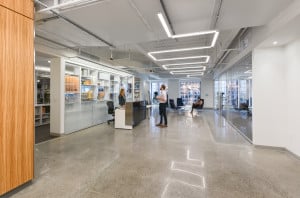Clients have questions for architectural firms about the new WELL building standards that rank work spaces in areas such as air quality, natural light and fitness facilities.
As Cambridge architect Tsoi Kobus Design relocated from Cambridge to downtown Boston, it incorporated WELL standards into its own plans to gain some first-hand knowledge.
“We started to talk to our clients and couldn’t answer most of their questions. We hadn’t experienced it, and it occurred to us we didn’t know what WELL cost,” Principal Rick Kobus said. “So we decided we should try it, and see how easy or difficult it was and whether we could afford it.”
Internal charrettes and email surveys studied employees’ work styles and shaped the new office’s designs.
“In a nutshell, individual spaces got smaller and we developed numerous team spaces that run the gamut from formal to informal,” he said.
Open floor plans dominate the bright, airy offices spanning 16,000 square feet on the 18th floor. Work stations are outfitted with sitting or standing desks, and lounge chairs in a large informal seating area near the company kitchen offer views of the North End and Faneuil Hall Marketplace.
It cost an additional 5 to 10 percent to meet WELL guidelines, such as testing of the building’s air and water quality, Kobus said. The firm removed traces of asbestos and installed filters to reduce chlorine levels in the water. Landlord Oxford Property Group installed new air handlers built to WELL standards.
After 34 years in Harvard Square, Tsoi Kobus found itself priced out of Cambridge’s real estate market and searching for new office space. The architecture firm toured buildings from Back Bay to the Seaport District before settling on 60 State St., a 38-story tower on the edge of the Financial District developed by Cabot, Cabot & Forbes in the early 1970s. With its move in May, Tsoi Kobus became the latest creative company to fill space in a downtown high rise traditionally favored by financial and legal industry tenants.
Tsoi Kobus looked at both class B buildings and towers, given the narrowing rent spreads between the two categories, Kobus said. Making a priority of designing to WELL building standards – including an abundance of natural light – ruled out most of the older class B buildings, he said.






